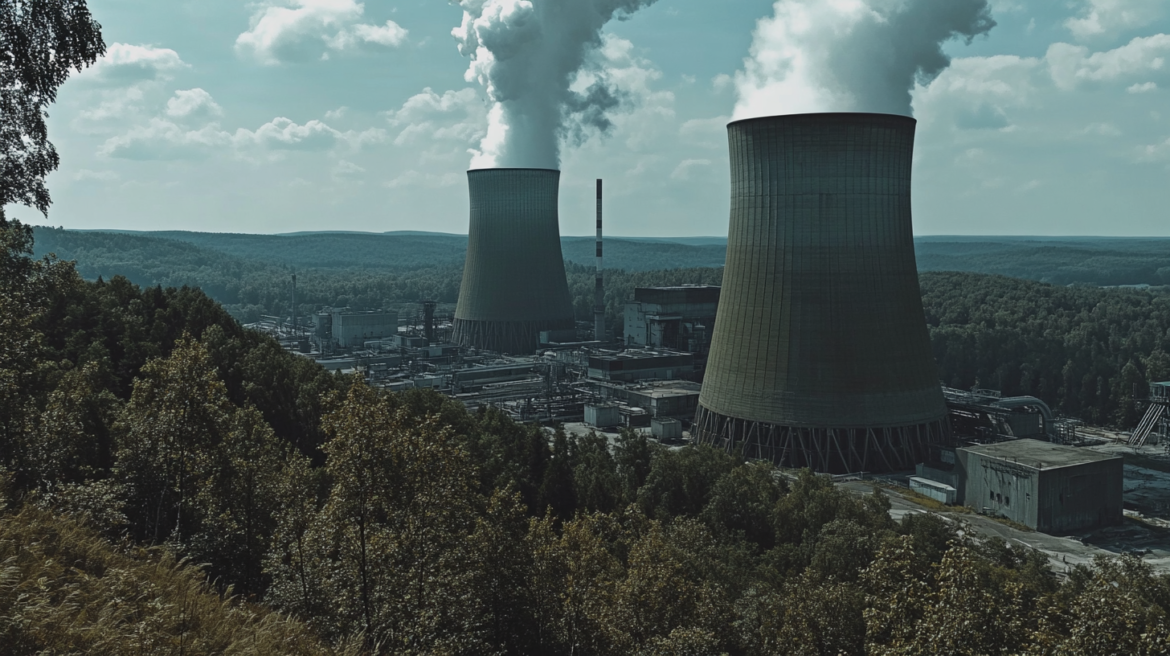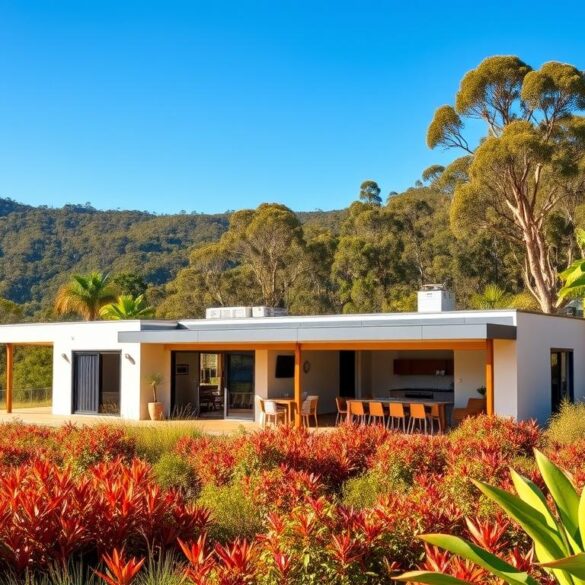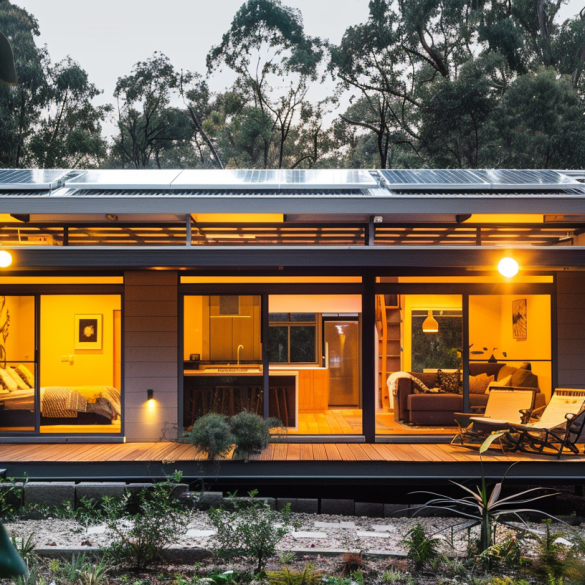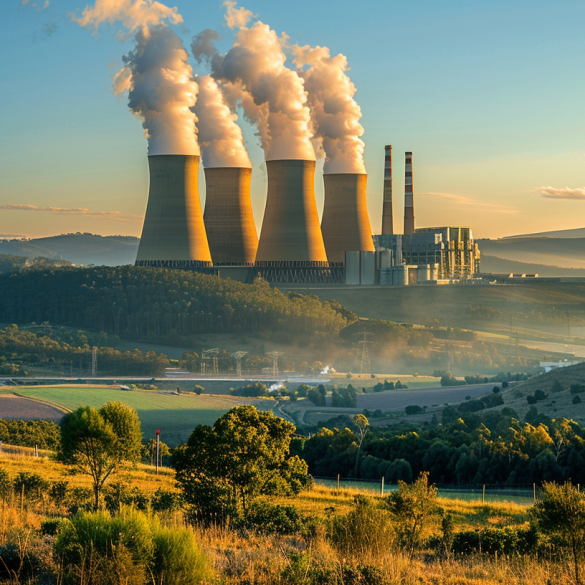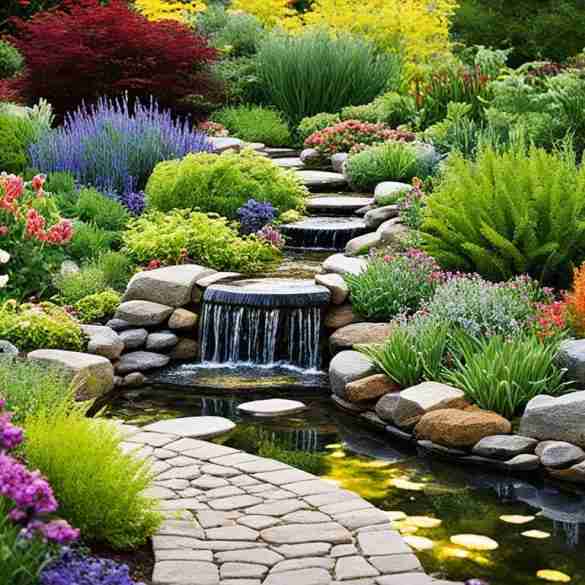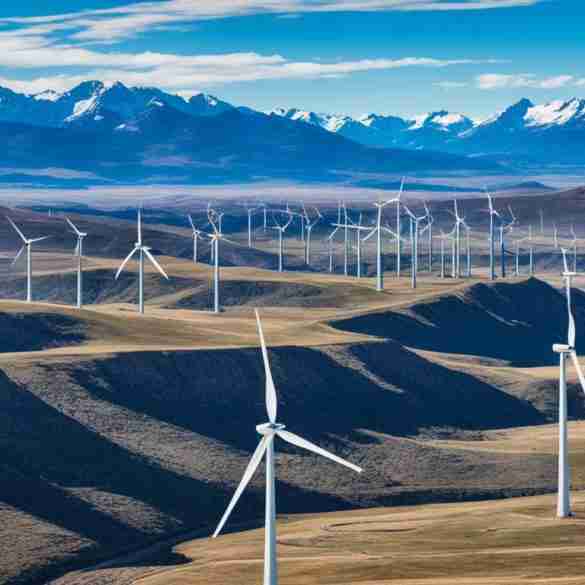Table of Contents
Nuclear Power: A Comprehensive Analysis of Reactor Technologies, Construction Timelines, Advantages, and Disadvantages
Nuclear Power
Nuclear Power advantages and disadvantages with around 440 reactors operationing it is a big part of the world energy making up about 9% of electricity globally
This report dives into nuclear power, covering the main reactor types, construction times, and the good and bad sides of it.
The report talks about how reliable and clean nuclear power is. It also points out the big challenges like dealing with radioactive waste and the risk of accidents. But, it also looks at new tech like Small Modular Reactors (SMRs) that could change the game for nuclear energy.
Table of Contents
Introduction for Nuclear Power advantages and disadvantages.
The world needs more energy, and worries about climate change and high electricity costs are growing.
This has made people look at building new nuclear power plants. Since the 1950s, nuclear tech has grown to be a key part of many countries’ energy plans.
This report will cover the different nuclear reactors used today, their tech, and how they work.
It will also look at how long it takes to build these plants and what can affect that time. Then, it will explore why nuclear power is good, like how reliable and clean it is.
But, it will also talk about the downsides, like dealing with waste and the risk of accidents.
It will compare the cost of nuclear power to other energy sources.
It will also look at new tech that could make nuclear power better.
Finally, it will show where nuclear power plants are around the world and what makes each type different.

Types of Nuclear Power Reactors
- A. Pressurized Water Reactors (PWRs)
PWRs are the most common nuclear reactors worldwide. They are used for electricity and in naval ships. They use ordinary water as both coolant and moderator.
These reactors have a two-circuit design. The primary circuit keeps water from boiling at high pressure. The secondary circuit uses this heat to make steam for turbines.
In Russia, they are called VVER types. They use enriched uranium dioxide fuel in long rods. Control rods manage the reaction rate. A secondary shutdown system uses boron to stop the reaction.
PWRs are well-understood and have a long history. But, they need strong safety systems and careful engineering. This can make building them take longer in places with strict safety rules.
- B. Boiling Water Reactors (BWRs)
BWRs are common in the U.S. and used in about ten countries. They heat water directly to make steam, which powers turbines.
Unlike PWRs, BWRs don’t need a separate steam generator. But, this direct steam cycle means the steam circuit and turbine get radioactive contamination. This requires extra shielding.
While BWRs are simpler, they need more safety measures. This might affect maintenance costs and procedures compared to PWRs.
- C. Advanced Gas-Cooled Reactors (AGRs)
AGRs were mainly built in the U.K. between 1976 and 1988. They use graphite as the moderator and carbon dioxide gas to cool the fuel.
The hot gas heats water in a steam generator to make steam. This steam drives the turbines. AGRs operate at high temperatures and pressures, making them more efficient.
They have higher thermal efficiencies and power densities than earlier designs. But, managing high-temperature gas systems is complex. This might make building them challenging.
- D. CANDU Reactors
The CANDU reactor is a heavy water moderated reactor from Canada. It has been exported to several countries. A key feature is its use of un-enriched uranium dioxide as fuel.
The fuel is placed in zirconium alloy cans in horizontal tubes. These tubes are cooled by high-pressure heavy water to prevent boiling. The heated water then makes steam to drive turbines.
More moderation is provided by a large, un-pressurized container called a calandria. The reactor’s power is controlled by inserting or withdrawing cadmium rods. A big advantage is that it can be refueled online without shutting down.
This design uses heavy water, allowing it to operate with natural uranium. It offers fuel cycle advantages and potentially reduces reliance on external enrichment services. However, the production and handling of heavy water increase the initial construction and operation costs.

- E. Small Modular Reactors (SMRs)
SMRs are much smaller than traditional nuclear plants, with outputs up to 300 MWe. They are designed for modular technology, with factory-fabricated components or entire units. These modules can be transported to the site for installation.
SMRs use nuclear fission to generate heat. This heat can be used directly or to produce steam for electricity. Designs vary in coolant, including light water, liquid metal, or molten salt.
A big advantage is the potential for reduced construction time and lower costs. Many SMR designs have enhanced safety features, often passive systems. Their smaller size and reduced cooling needs offer flexibility for site selection.
SMRs can be scaled up by adding more modules. Several companies, like NuScale and GE Hitachi, are developing SMR technologies. They aim to overcome traditional nuclear project challenges with modularity and safety, for wider application.
Other Advanced Reactor Designs
- 1. Fast Reactors: Fast reactors use fast neutrons to keep the nuclear reaction going. They don’t need a moderator like thermal reactors do. This lets them use more types of fuel, like depleted uranium and actinides from old fuel. Some designs can even make more fuel than they use, making nuclear power more sustainable.
These reactors can use coolants like liquid sodium, lead, or gas. This makes them powerful and efficient. China is working on a fast reactor called CFR600. Fast reactors could make nuclear power more efficient and use up old nuclear waste.
- 2. Molten Salt Reactors (MSRs): MSRs use molten salt as their coolant and sometimes as fuel. They can run at high temperatures and low pressures. This makes them efficient and safe.
MSRs are good for making electricity and also for industrial uses like hydrogen production. There are different designs, like the Seaborg CMSR and Terrestrial Energy’s IMSR. MSRs are a new way to make nuclear reactors safer and more versatile.
- 3. High-Temperature Gas-Cooled Reactors (HTGRs): HTGRs use graphite and helium to reach very high temperatures. This makes them great for making electricity and process heat. They’re safe because helium is an inert gas.
China’s HTR-PM is an example of a working HTGR. BWX Technologies is also working on a small, portable reactor. HTGRs are a way to make efficient power and use heat for other things, thanks to helium and graphite.
Construction Timelines for Nuclear Power Plants
A. Typical Construction Durations by Reactor Type.
The building of a nuclear power plant takes about five to ten years. But, the whole process from start to finish can take over ten years. For Pressurized Water Reactors (PWRs), the time varies by country.
In Germany, France, and Russia, it’s around 80 months. In Japan, it’s about 60 months.
In a broader view, 95% of PWR projects take between 50 to 250 months. The average time for a PWR unit is about 7 years.
But, the median time for reactors finished in 2019 was just under 10 years. Boiling Water Reactors (BWRs), especially Small Modular Reactors (SMRs), are expected to be built faster. For example, GE-Hitachi’s BWRX-300 SMR is set to take 2-3 years to build.
The overall median construction time for all reactors is about 76 months (just over six years). The mean average is 91 months. Advanced Gas-Cooled Reactors (AGRs) have faced longer and more challenging construction.
The first commercial AGR at Dungeness B was finished 13 years late.
The Hinkley Point C project in the UK, using EPR technology, started in 2017. It’s expected to finish around 2031, taking about 14 years 32. CANDU Reactors have shown shorter construction times in some cases.
In China, the average time for CANDU 6 reactors is about 4.7 years. Canada has built them in 6 to 7 years.
A project in China set a record of 51.5 months from first concrete to criticality. Small Modular Reactors (SMRs) are expected to be built much faster. Experts say they will take an average of 3 years to build, with some versions taking 3.5 to 4 years.
Ontario Power Generation (OPG) expects its first SMR (BWRX-300) to be done in about 3 years from starting construction.
These numbers show a wide range in construction times for nuclear power plants. While big reactors take 7-10 years or more, SMRs aim to cut this time significantly.
B. Factors Influencing Construction Timelines.
Many factors can affect how long it takes to build a nuclear power plant. Regulatory processes, like licensing and permits, can be long and complex. They often involve environmental assessments and public talks.
The technology used in nuclear plants is complex. It needs special materials and safety features, making construction longer than other power plants.
Good project management and teamwork among all involved are key to faster building. Countries using standard reactor designs build faster.
Experience in building nuclear reactors also matters. Countries with a history in nuclear building do it faster. The cost of financing is higher with longer construction times. Public opposition can cause delays through protests and legal issues.
The supply chain for special parts and materials can also slow things down.
Political changes and labor issues can add to delays. These factors show that building time is not just about the technology. It’s also about rules, management, money, society, and politics.
Advantages of Nuclear Power
- A. High Energy Density and Fuel Efficiency
Nuclear power has a high energy density. This means a lot of energy is packed into a small amount of fuel. The energy from nuclear fission is ten million times more than burning fossil fuels. - B. Reliable Baseload Power Generation
Nuclear power plants are very reliable. They can run 24/7, all year, no matter the weather. They have the highest capacity factors, often reaching 90% or more. - C. Low Greenhouse Gas Emissions and Reduced Air Pollution
Nuclear power has a small impact on air quality and climate change. It doesn’t produce direct carbon dioxide emissions 8. It saves the atmosphere from hundreds of millions of metric tons of carbon dioxide each year. - D. Energy Security and Fuel Availability
Nuclear power is secure because it uses uranium, which is abundant and diverse. It needs much less fuel than coal or oil. Fuel costs for nuclear plants are a small part of their total costs, making electricity prices more stable.
Disadvantages of Nuclear Power
- A. Radioactive Waste Management and Disposal
Nuclear power creates radioactive waste at different stages. This waste stays dangerous for thousands to millions of years. There’s no agreed-upon way to dispose of it permanently. Most is stored in temporary places, like pools, which are running out of space. - B. Potential for Accidents and Safety Concerns
Nuclear power plants can still have accidents, despite safety efforts. Past incidents like Three Mile Island, Chernobyl, and Fukushima Daiichi show the risks. These accidents can harm people’s health and make areas unsafe for years. - C. Security Risks and Nuclear Proliferation
Nuclear power raises security concerns, like the risk of nuclear weapons. The spread of nuclear technology worries experts. Plants and facilities could be targets, leading to dangerous leaks. - D. High Initial Capital Costs and Long Construction Periods
Starting a nuclear power plant costs billions. This makes it seem expensive compared to other energy sources. Building one takes over a decade, which is a big drawback for meeting quick energy needs.

Economic Analysis: Cost of Nuclear Power
A. Comparison of Capital Costs with Other Energy Sources.
The cost to build and finance nuclear power plants is very high. In 2014, the U.S. Energy Information Administration found that these costs make up about 74% of the total cost of nuclear electricity. This is more than the costs for coal (63%) and natural gas (22%) power plants.
- For a large nuclear power plant, the cost can range from $7,675 to $12,500 per kilowatt. Newer estimates suggest a range of $8,475/kW to $13,925/kW, with the higher end reflecting costs like Plant Vogtle. In comparison, a 600 MWe coal plant costs between $3,000 to $8,400/kW.
- Studies by Lazard show that solar and wind power have an average cost of $40 per megawatt-hour. Nuclear plants average around $175, showing a big difference in costs. However, Small Modular Reactors (SMRs) could have lower costs. A 114-MW SMR unit might cost around $2,901 per kW, compared to $6,936 per kW for a 1,144-MW conventional Pressurized Water Reactor (PWR) unit.
- These comparisons show the high upfront cost of nuclear power plants. This is a key factor in their economic competitiveness.
B. Analysis of Operating and Maintenance Costs
- Nuclear power plants have high initial costs but low operating costs. These costs include fuel, operation and maintenance (O&M), decommissioning, and waste disposal. Fuel costs for nuclear plants are usually very low, around 0.50 cents per kilowatt-hour at a burn-up rate of 45,000 MWd/t.
- In OECD countries, nuclear fuel costs are about one-third of coal-fired plants and between a quarter and a fifth of gas combined-cycle plants. In the United States, the average total generating cost for nuclear energy in 2020 was $29.37 per megawatt-hour (MWh). This is lower than the average of $33.50 per MWh in 2017.
- However, operating costs, excluding fuel and capital, have been increasing in the U.S. leading up to 2017. Decommissioning costs are estimated to be around 9-15% of the initial capital cost of a nuclear power plant. When discounted over the plant’s lifetime, they contribute only a small percentage to the overall generation cost.
- The low and stable fuel costs of nuclear power provide an economic advantage. This is especially true when compared to the fluctuating prices of fossil fuels. However, the trend of increasing operation and maintenance costs highlights the need for efficient plant management to maintain nuclear power’s economic competitiveness.
C. Levelized Cost of Electricity (LCOE) Comparison
- The Levelized Cost of Electricity (LCOE) is key for comparing the cost of different power sources. The U.S. Energy Information Administration says advanced nuclear power costs $110/MWh. This cost is expected to stay the same until 2050.
- In 2023, solar photovoltaic (PV) cost was $55/MWh. It’s expected to drop to $25/MWh by 2050. Onshore wind cost was $40/MWh in 2023 and will fall to $35/MWh by 2050 74.
- Lazard’s analysis shows solar and wind costs around $40/MWh. Nuclear power costs about $175/MWh 70. But, Small Modular Reactors (SMRs) could cost as low as $36/MWh for a 114-MW SMR, compared to $92/MWh for a 1,144-MW PWR 71.
- Nuclear power is competitive with renewables when capital costs are between $2000 and $3000 per kilowatt 66. The cost of nuclear power is influenced by many factors, including capital and operating costs, fuel prices, and government policies 41.
- While renewables might seem cheaper, SMRs could make nuclear power more affordable.
Recent Advancements and Innovations in Nuclear Technology
- A. Small Modular Reactors (SMRs): Technology and Benefits
SMRs are nuclear reactors that produce up to 300 MWe. They are made in factories and built quickly. This makes them cheaper and faster to deploy than big reactors. - They have safety features that work without human help. This is because they use passive systems that can shut down the reactor automatically. SMRs can be used in many places, including remote areas and industrial sites. They are good for making electricity and for heating processes.
- There are over 80 SMR designs in development worldwide. Companies like NuScale and GE Hitachi are working on them. The U.S. Nuclear Regulatory Commission approved the first SMR design in 2020. SMRs could make nuclear power more affordable and reliable.

- B. Generation IV Reactor Designs: Enhanced Safety and Efficiency
Generation IV reactors aim to be safer, more efficient, and cheaper. They include designs like the Gas-cooled Fast Reactor and the Molten Salt Reactor. These reactors use natural phenomena to stay safe in emergencies. - They can work at higher temperatures, making them more efficient. This also means they can be used for things like making hydrogen. Some designs can even make more fuel than they use, reducing waste.
- These reactors are still being developed, but they show the future of nuclear power. They focus on being safe, sustainable, and versatile.
- C. Other Emerging Technologies (e.g., Fusion)
Nuclear fusion is a new tech that could give us clean, endless energy. It’s different from nuclear fission, which splits atoms. Fusion joins smaller atoms together, like hydrogen isotopes, to make bigger ones and release lots of energy. - It’s a big plus that fusion makes almost no carbon emissions and less radioactive waste than fission. The waste it does make is safer and might even be recyclable. The fuel for fusion, like deuterium and tritium, is easy to find and use.
- Fusion is also safer than fission because it can’t get out of control . But, making fusion work for energy is still a big challenge. Still, scientists are making progress, hoping to have fusion power in a decade.
- Nuclear fusion is a dream for clean, endless energy in the future.
IX. Global Landscape of Nuclear Power
- A. Countries Utilizing Nuclear Power
Nuclear power is key in many countries’ energy plans. Today, 31 countries, plus Taiwan, have nuclear power plants. In 2023, 14 countries got 25% or more of their electricity from nuclear. - France leads, getting 70% of its electricity from nuclear 1. Ukraine, Slovakia, and Hungary also rely heavily on nuclear power, each getting half of their electricity from it. The U.S. is the biggest producer of nuclear power, showing its big role in the world’s energy mix.
- More than 30 countries use nuclear power, showing its global importance. Many countries count on it as a main source of electricity.
B. Number of Operational Nuclear Power Plants by Country (2024)
By early 2025, 411 nuclear power reactors were working worldwide. Here’s how these reactors are spread out by country:
| Country | Number of Operational Reactors |
| United States | 93 |
| France | 56 |
| China | 55 |
| Russia | 37 |
| South Korea | 26 |
| Canada | 19 |
| India | 19 |
| Ukraine | 15 |
| Japan | 12 |
| United Kingdom | 9 |
| Spain | 7 |
| Sweden | 6 |
| Czech Republic | 6 |
| Pakistan | 6 |
| Belgium | 5 |
| Finland | 5 |
| Slovakia | 5 |
| Hungary | 4 |
| Switzerland | 4 |
| Taiwan | 3 |
| Argentina | 3 |
| United Arab Emirates | 3 |
| Belarus | 2 |
| Brazil | 2 |
| Bulgaria | 2 |
| Mexico | 2 |
| Romania | 2 |
| South Africa | 2 |
| Armenia | 1 |
| Iran | 1 |
| Netherlands | 1 |
| Slovenia | 1 |
This table shows that most nuclear reactors are in a few countries. The United States, France, and China have the most.
- Trends in Global Nuclear Power Deployment The history of nuclear power shows different phases. The first commercial nuclear power stations started in the 1950s. Then, a peak in construction happened from the mid-1960s to the early 1980s.
- A retrenchment followed after the Chernobyl accident in 1986. This was due to safety concerns and rising costs. Recently, there’s a renewed interest in nuclear power because of climate change and energy security.
- Now, most new nuclear projects are in Asia, especially in China and Russia. The number of countries starting new nuclear projects decreased in 2024. There’s also a focus on making existing plants last longer.
- Moreover, there’s growing interest in Small Modular Reactors (SMRs). They are seen as a flexible and cost-effective option. These trends show a changing world for nuclear power, driven by technology, economics, and politics.
Case Studies of Nuclear Power Plant Construction Projects
- A. Examples of Successful and Challenging Projects
Looking at specific nuclear power plant construction projects gives us insights. The River Bend Nuclear Power Station Unit 1 in the USA was finished in 72 months in the 1980s. It’s seen as a success due to good project management. - China’s Qinshan project also showed fast construction times for its CANDU reactors. But, the Plant Vogtle Units 3 & 4 project in the USA faced big delays and cost overruns. Unit 3 started operating in 2023, and Unit 4 is set to start in 2024.
- The Hinkley Point C project in the UK and the Olkiluoto 3 EPR project in Finland also had delays. But, the Taishan 1&2 EPR projects in China were done more quickly. This shows the value of learning and standardization.
- The Natrium Advanced Reactor Demonstration Project in the USA aims to build faster and safer. It started in 2024. These examples show how different nuclear plant construction can be, with successes tied to good management and standardization.
- B. Lessons Learned from Construction Experiences
Different nuclear power plant construction projects have taught us a lot. Working together among all involved can make projects faster. Using the same reactor designs can also make things more efficient. - Modular construction, especially for Small Modular Reactors, can make building easier and cheaper. Making licensing and rules clearer is key to avoiding delays. Public support and good communication are also crucial.
- Strong project management and a skilled team are vital for success. Learning from past projects is important for making future nuclear power plants better and more predictable.
Final Thoughts:
Nuclear power uses many reactor types, each with its own technology and way of working. Pressurized Water Reactors (PWRs) are the most common worldwide. They use high-pressure water as coolant and moderator.
Boiling Water Reactors (BWRs) make steam right in the reactor. Advanced Gas-Cooled Reactors (AGRs) in the UK use graphite and gas for better efficiency. CANDU reactors, mainly in Canada, use heavy water and natural uranium.
Small Modular Reactors (SMRs) are a new type of reactor. They are smaller, made in factories, and safer. New reactor designs aim for better safety, sustainability, and uses.
Building nuclear power plants takes different amounts of time, from 5 to over 10 years. This depends on rules, technology, management, standardization, and public support. SMRs aim to be built in just a few years.
Nuclear power has many benefits, like high energy density and fuel efficiency. It also provides reliable power, unaffected by weather. Plus, it has low greenhouse gas emissions and reduces air pollution compared to fossil fuels.
However, there are downsides. Managing and disposing of radioactive waste is a big challenge. There’s also the risk of severe accidents and security concerns. Additionally, starting a nuclear project is expensive and takes a long time.
Worldwide, over 30 countries use nuclear power. The United States, France, and China lead in the number of reactors. Climate change has sparked a renewed interest in nuclear power, especially in Asia.
New technologies like Small Modular Reactors (SMRs) are being developed. Successful projects show the value of good project management and stable rules. This ensures projects are completed on time.
In summary, nuclear power is key for a low-carbon energy mix. Despite ongoing challenges, advancements in SMRs and Generation IV reactors could improve nuclear power’s role in a sustainable future.

